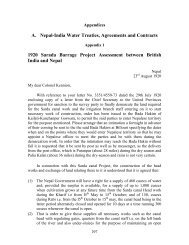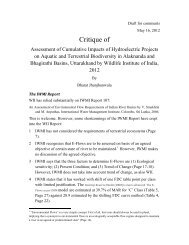Proposed Power Development Plan (PDP) 2012 - Palang Thai
Proposed Power Development Plan (PDP) 2012 - Palang Thai
Proposed Power Development Plan (PDP) 2012 - Palang Thai
- No tags were found...
Create successful ePaper yourself
Turn your PDF publications into a flip-book with our unique Google optimized e-Paper software.
<strong>Proposed</strong> <strong>Power</strong> <strong>Development</strong> <strong>Plan</strong> (<strong>PDP</strong>) <strong>2012</strong>and a Framework for Improving Accountability and Performance of <strong>Power</strong> Sector <strong>Plan</strong>ningAssumptions on Resource optionsEnergy Efficiency (EE) / Demand Side Management (DSM)In addition to the assumed energy savings in the <strong>PDP</strong> 2010 from the T5 light replacement measure which isexpected to deliver a peak saving of 584 MW, we assumed additional savings from new voluntary and mandatorymeasures consistent with the government’s 20-year Energy Efficiency <strong>Development</strong> <strong>Plan</strong> to reduce year 2030power consumption by 20% or 52,224 GWh. The targets and recommended measures in the plan are realistic,doable and based on well-researched and conservative analysis by a team of energy and policy academics andpractitioners. The budget for the plan has already been approved and disbursed. It is important however to have agood evaluation and monitoring system in place to ensure that the budget is spent effectively and delivers thesavings as planned. For details on the suggested EE measures, see Ministry of Energy (2011) and Foongthammasan,Tippicha i et al. (2011).The savings from T5 light replacement which has already been deducted from the official demand forecast used inthe <strong>PDP</strong> 2010 is considered part of the baseline (or business-as-usual) according to the 20-year Energy Efficiency<strong>Plan</strong>. In our analysis of the <strong>PDP</strong> <strong>2012</strong>, we only consider additional savings beyond the T5 program. The savings aretreated as a resource or investment options. Even though the savings happen on the demand side, in our analysiswe follow the Pacific Northwest practice of treating EE/DSM savings as a supply option, competing on a levelplaying field against other generation options in terms of resource amount, cost, etc.The energy savings from the T5 light replacement program has an expected load factor of 56%, according to the<strong>PDP</strong> 2010. <strong>Thai</strong>land’s power system has a load factor of around 75%. For this study, we assumed that additional EE/DSM savings have a load factor of around 60%. Based on this assumption, we convert the GWh savings into MWsavings. The savings start off small (0.4% in 2013) and increase progressively toward the target of 20% energysavings compared to the projected demand in 2030. The energy savings in GWh and MW incorporated in the<strong>PDP</strong> <strong>2012</strong> over the planning period are shown in Table 10.YearEE saving in <strong>PDP</strong> 2010* Additional EE savings in <strong>PDP</strong> <strong>2012</strong>GWh MW % of total energy GWh MW2010 210 43 - - -2011 629 129 - - -<strong>2012</strong> 1,049 215 - - -2013 1,678 344 0.4% 672 1282014 2,307 473 1.0% 1,665 3172015 2,852 584 1.7% 3,005 5722016 2,433 498 2.5% 4,571 8702017 1,804 369 3.5% 6,529 1,2422018 965 198 4.5% 8,591 1,6342019 1,170 240 5.6% 11,079 2,1082020 1,170 240 6.6% 13,525 2,5732021 1,170 240 7.7% 16,253 3,0922022 1,170 240 8.9% 19,104 3,6352023 1,170 240 10.1% 22,255 4,2342024 1,170 240 11.2% 25,537 4,8592025 1,170 240 12.6% 29,324 5,5792026 1,170 240 14.0% 33,451 6,36422
















